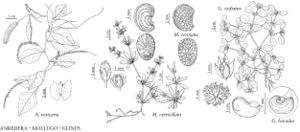Glinus
Sp. Pl. 1: 463. 1753.
Gen. Pl. ed. 5, 208. 1754.
| Taxon | Illustrator ⠉ | |
|---|---|---|
 | Anredera vesicaria Mollugo verticillata Glinus lotoides | Bee F. Gunn Bee F. Gunn Bee F. Gunn |
Herbs, annual, stellate, pubescent. Stems prostrate to ascending, branching from base. Leaves alternate or whorled; stipules absent. Inflorescences axillary, cymose; cymes dense, reduced. Flowers sessile or short pedicellate; sepals persistent, 5, basally connate, abaxially stellate-pubescent; petals absent (or 5–20); stamens (3–) 5 (–20), alternate with sepals, distinct or fascicled; pistils 3–5-locular; ovules 10–25 per locule; styles 1 (–5), terminal, erect, or stigmas sessile. Fruits capsular, 3–5-valved. Seeds: somewhat flattened laterally, asymmetrically reniform, smooth to tuberculate, funiculus develops into a long, slender strophiole. x = 9.
Distribution
North America, West Indies, Central America, South America, Eurasia, Africa, Australia
Discussion
Species 6 (2 in the flora).
Several species of Glinus have medicinal value. Glinus oppositifolius has been used as a vegetable in Africa, India, and the Philippines, and to treat diarrhea, boils, bilious attacks, headache, and joint pain (H. M. Burkill 1985; K. R. Kirtikar and B. D. Basu 1935; A. K. Tripathi 1988). K. M. Alikutty and N. M. Aleyas (1978) presented evidence that G. oppositifolius is toxic to cattle, when fed in large quantities.
Selected References
None.
Lower Taxa
Key
| 1 | Seeds smooth, highly glossy, 0.4-0.5 × 0.2-0.3 mm; sepal apex long-acuminate or attenuate | Glinus radiatus |
| 1 | Seeds papillate, somewhat glossy or dull, 0.4-0.6 × 0.3-0.4 mm; sepal apex rounded to acute or slightly mucronate | Glinus lotoides |